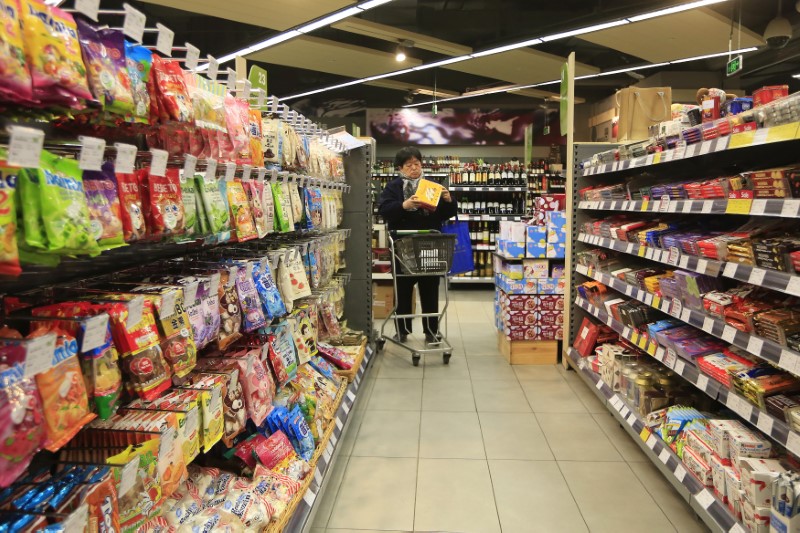 © Reuters. A customer selects products at a supermarket in Shanghai
© Reuters. A customer selects products at a supermarket in ShanghaiBEIJING (Reuters) – China’s factory-gate inflation cooled for a third straight month in September amid ebbing domestic demand, pointing to more pressure on the world’s second biggest economy as it remains locked in an intensifying trade war with the United States.
Consumer inflation, on the other hand, picked up slightly in September from the previous month, led mainly by higher food prices, official data showed on Tuesday.
Overall, pricing pressures were contained, giving authorities the flexibility to ease monetary policy to shore up slowing growth. Over the weekend, central bank governor Yi Gang said he sees plenty of room for adjustment in interest rates and banks’ reserve requirement ratio due to significant downside risks from the Sino-U.S. trade row.
Indeed, economic activity has been slackening in the past few months, prompting the People’s Bank of China (PBOC) to announce another cut to banks’ reserve requirement ratio (RRR) just over a week ago – the fourth reduction this year.
For this year, Yi said that CPI will likely come in about 2 percent and expects PPI between 3-4 percent.
The producer price index (PPI), a gauge of industrial profitability, rose 3.6 percent in September from a year earlier, compared with a 4.1 percent increase in August, according to data released by the National Statistics Bureau on Tuesday.
On a monthly basis, the PPI picked up to 0.6 percent from 0.4 percent in August.
Analysts polled by Reuters had expected September producer inflation would cool to 3.5 percent as both external and domestic demand weakened.
Profit growth at China’s industrial firms slowed to a five-month low in August, fanning concerns about faltering domestic demand.
The trade row with Washington appears to be already impacting industries. Growth in China’s factory sector in September stalled after 15 months of expansion, with export orders falling the most in more than two years, a private business survey showed. An official survey also confirmed a further manufacturing weakening.
Prices of raw materials rose 7.3 percent in September from a year earlier, down from a 7.8 percent increase in August, according to the statistics bureau.
The consumer price index (CPI) rose 2.5 percent from a year earlier, in line with expectations of 2.5 percent and accelerating from August’ s 2.3 percent gain. It still remained comfortably below China’s inflation goal of 3 percent for 2018, same as last year.
The core consumer price index, which strips out volatile food and energy prices, rose 1.7 percent year-on-year, compared with 2.0 percent in August.
The food price index increased 3.6 percent in September, up sharply from the 1.7 percent annual gain in September, due to extreme weather conditions such as seasonal typhoons, heavy rains and hailstorms, according to the NBS.
China’s economic growth cooled slightly to 6.7 percent in the second quarter, though worries about a sharper slowdown in coming quarters have increased in recent months amid the rocky trade relations with the United States.
The two countries have already slapped tit-for-tat tariffs on each other’s goods, and U.S. President Donald Trump has warned that he was ready to slap tariffs on virtually all Chinese imports into the United States.
If China goes ahead with a 15 percent tariff on $60 billion U.S. goods, it could lead to a one-time impact of a 0.2-0.3 percentage point gain on China’s consumer inflation, according to estimates from Morgan Stanley (NYSE:).
“We expect headline inflation to hover around 2 percent over the coming year, but upside risks have increased,” economists at Capital Economics wrote in a recent report.
“Developments in the real economy should help to keep a lid on inflationary pressures over the months ahead.”
Source: Investing.com



























